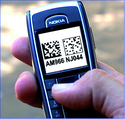Barcoding and the start of a retail revolution
2 December 2009On the 35th anniversary of the bar code, we look at its revolutionary impact on the retail sector
Bar code technology has evolved to produce an array of auto ID systems that will bring valuable benefits to the packaging industry and consumers, says Mark Thomson.
New generation RFID and barcode technologies will process ever larger amounts of data at longer ranges across a bigger group of items.
The world’s largest importers and exporters are looking at RFID for their shipments. RFID allows detection and recording of any tampering with a seal that was applied at the point of origin, so can add a level of security to containers arriving for inspection.
Shipments from overseas can earn ‘green lane’ status under the US Customs Trade Partnership Against Terrorism (C-TPAT) programme, which moves goods through inspections much faster, resulting in significant productivity gains. Freight forwarders and shippers are now exploring the technology at the request of importers and exporters, with an eye to implementation within three years.
In the clothing sector, Prada is using RFID labels and tags on products to determine authenticity and curb the ‘knock-off’ market, and use tamperevident labels, holograms and specially coded materials to tackle counterfeiting.
The retail sector - the Topshop chain of clothing stores in Russia, for example - is using auto ID to address changing customer demands. We are on the verge of a new generation of self scan and auto ID products as consumers increasingly demand an experience to match internet shopping, such as ability to compare product prices and specifications in store. This is becoming even more important to FMCG retailers as price and product information becomes central to consumer buying habits.
RFID-enabled retail packs will allow us to:
• price goods against basket prices of supermarket competitors
• see enhanced information on nutrition, allergenics and food sources
• preload shopping lists with special offers relevant to shopping habits appearing when the customer is in the aisle where those products are located
• find out for themselves where products are located in the store
• look up a recipe and print out the ingredients list on entering the store
Such applications will become pervasive very quickly and certainly within the next three years, driven by increasingly sophisticated customer demands and marketing methods. And industry reliance on RFID will grow as it improves data management, security, productivity and customer satisfaction, and reduces costs and waste for companies.
RFID tagging guidance for ‘a better shopping experience’ Retailers and brand owners now have reliable guidance on how they can use a single RFID-based tag to cut supply chain costs, avoid stock-outs, and monitor theft and create a better shopping experience.
The Strategic Overview Guide and Technical Implementation Guide for GS1 EPCglobal RFID-based Electronic Article Surveillance (EAS) relate to reusable and disposable tags.
EPCglobal, a subsidiary of the global standards organisation GS1, explains how to implement RFID-based EAS solutions in a retail environment using existing GS1 and GS1 EPCglobal Gen 2 standards.
The next phase of the work will include updates to the technical standards to address tags that are embedded - that is, those not easily removed and requiring electronic deactivation or tag alteration.
The goal is to harness the combined benefits of EPC (Electronic Product Code) and RFID (Radio Frequency Identification) to extend the value of EAS, say the authors of the guides. RFID enables increased visibility, improved inventory tracking and process productivity along the supply chain up to the retail sales floor; and EAS provides item-level theft deterrence, detection, and protection, states EPCglobal.
According to EPCglobal, a single technology and simplified tagging process can reduce costs in the retail chain by having one standardised inventory. This will help drive the adoption of EPC item-level tagging; and increase product availability, speed and quality of service, enhancing the shopping experience. Retailers will be able to know when a theft incident is occurring, what was stolen and to re-stock the shelf.
“There are enormous benefits to combining the advantages of EPC/RFID and EAS technology in a single tag, and the concept is expected to gain support throughout the retail industry,” said Paul Chamandy, vice-president, new business development at Avery Dennison, which worked on the guides with a number of partners.
Dr. Gerd Wolfram, head of CIOOffice at retailer Metro, said: “By using RFID technology for EAS and inventory visibility, we can further integrate supply chain processes, and the potential to have distributed benefits for everyone involved is significantly enhanced.”
The guides can be downloaded at: www.epcglobalinc.org
Mark Thomson is market development manager at Zebra Technologies Europe
Retail revolution Breakthroughs in packaging technology such as the Univocal coding system by Gidue (see PT October 2009) continue to drive retail efficiency Gidue


